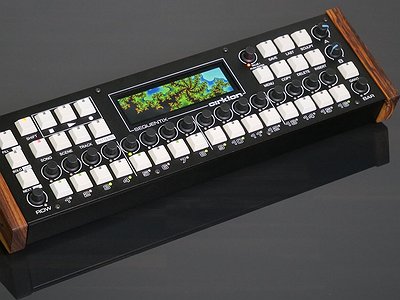Name: Benjamin O'Shea aka Benjamin Damage
Nationality: Welsh
Occupation: Producer
Recent release: Benjamin Damage is one of the artists featured on Sven Väth's Catharsis Remixes album, out via Cocoon. Other artists featured on the release include Harald Björk, Roman Flügel, Robag Wruhme, Krystal Klear, and Mano le Tough.
[Read our Harald Björk interview]
[Read our Roman Flügel interview]
[Read our Robag Wruhme interview]
[Read our Krystal Klear interview]
Tool of Creation: Sequentix Cirklon Sequencer
Type of Tool: Hardware-Sequencer
Designed by: Colin Fraser @ Sequentix
Years produced: 2011-
Country of origin: UK/Germany
If you enjoyed this interview with Benjamin Damage about the Sequentix Cirklon Sequencer and would like to stay up to date with his music, visit him on Instagram, Soundcloud, and twitter.
What was your first encounter with the Sequentix Cirklon Sequencer?
I was playing live with a computer and it didn’t make sense to me to be splitting up tracks into individual stems further and further. It’s a destructive process starting from the master recording and then introducing increasing complexity.
It made more sense to start with silence and then rebuild the tracks using the machines from scratch. The more you put into it, the better it sounds. This way you can eventually surpass the original track and breathe new life into it.
This led me to look for hardware sequencers to buy. I considered a Yamaha QY700 and even put a bid on eBay for one at one point. But when I read what the Cirklon was capable of it was an easy decision to get on the waiting list for it.
Just like any other piece of equipment, the Sequentix Cirklon Sequencer has a rich history. Are you interested in it? And if so, what are some of the key points from this history for you personally?
Absolutely. The sequencer came out in 2011 as a development of the Sequentix P3 but some of the design elements are based on much older machines.
The name comes from the “Circle Machine”, a mechanical sequencer that used a motor and light sensors to trigger pulses that could control sound. It was designed in the 1950s by Raymond Scott and kept secret for decades.
What, to you, are some of the most interesting recordings made with the Sequentix Cirklon Sequencer?
I’m not sure exactly what tracks have been recorded with the Cirklon. It’s very fun to play with live.
What interests you about the Sequentix Cirklon Sequencer in terms of it contributing to your creative ideals?
It’s very quick to find grooves and get ideas started quickly. When I’m in a creative mindset I like to get as much done as quickly as possible while the ideas are fresh.
Manipulating patterns with other patterns leads to some very interesting results.
Benjamin Damage Interview Image (c) the artist
Some see instruments and equipment as far less important than actual creativity, others feel they go hand in hand. What's your take on that?
Everyone expresses their creativity in different ways, so you have to do whatever works for you.
Personally I like to change it up often. Sometimes I’ll be writing all on hardware, other times I’ll be playing in melodies on a MacBook keyboard on a plane.
It’s about pushing yourself to find new ideas and not getting too comfortable doing the same tricks.
In the light of picking your tools, how would you describe your views on topics like originality and innovation versus perfection and timelessness in music? Are you interested in a “music of the future” or “continuing a tradition”?
I just do what feels natural to me and let other people make up their minds. You can’t control what happens to your music after you release it. Tracks can be totally ignored, hyped and forgotten or resurrected years later.
I think you should just express yourself as best as you can at the time and then move on.
What are some of the stand-out features from your point of view?
Being able to clock the whole studio together with exact precision. It has 5 midi ports, 16 via USB, 16 cv etc so you can connect everything up and just start creating straight away.
Prior to using it for the first time, how did you acquaint yourself with the Sequentix Cirklon Sequencer? Will you usually consult a manual before starting to work with a new device – and what was that like for the Sequentix Cirklon Sequencer?
Quite a few of the features aren’t even in the manual! The firmware gets updated very regularly and it’s in constant development.
Even though it’s intuitive there are quite a few features which you do need to learn before it becomes an integral part of your setup.
Tell me a bit about the interface of the Sequentix Cirklon Sequencer – what does playing it feel like, what do you enjoy about it, compared to some of your other instruments?
I’ve used hardware sequencers like the Korg Trinity and the power and flexibility of the Cirklon is far, far beyond anything like that.
The Cirklon interface is based very loosely on the TR-909 and many other sequencers. With its 16 button programming interface it is more suited to 4/4 music and dance music in general.
In which way does the Sequentix Cirklon Sequencer influence musical results and what kind of compositions does it encourage / foster?
It’s very easy to do polyrhythms and parts that interact with each other. It’s capable of quite amazing controlled chaos.
More generally, how do you see the relationship between your instruments and the music you make?
Everything you use to make music influences you in subtle ways, some of which you’re not aware of.
Whether that’s hardware or software, every design choice has an effect on the creative process.
Could you describe working with the Sequentix Cirklon Sequencer on the basis of a piece, live performance or album that's particularly dear to you, please?
On my next upcoming BDB release with Bicep we used the Cirklon extensively.
I programmed a pseudo random pattern controlled by another pattern that followed the chord sequence and put it through a modular setup they have in their studio. Then I used controllers to adjust it in real time.
How does the Sequentix Cirklon Sequencer interact with some of the other tools in your studio?
The Cirklon doesn’t have its own sounds so the only way it works is by interacting with the rest of the studio.
It works with MIDI, cv/gate and USB. That allows you to work with pretty much everything.
Are there other artists working with the Sequentix Cirklon Sequencer whose work you find inspiring? What do you appreciate about their take on it?
I’m a huge fan of Aphex Twin - he’s one of the most famous users. You can see snippets of the internal Cirklon code at the start of his “T69 Collapse” music video.





